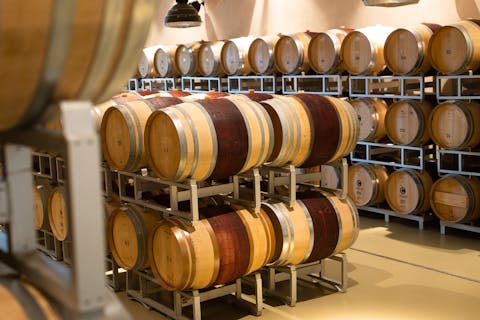
Cellar
Peace, silence, fragrance. An ideal meditation haven where wines calmly rest: in amphorae, cement, and barriques.

Architecture
Tenuta Casadei’s cellar is a treasure chest built in the earth and rock of Suvereto, a vibrant shrine where our efforts, vineyard labor and commitment to the principles of BioIntegrale® converge, turning into precious barrique and amphora-aged wines.
Low-impact winemaking in a sustainable winery. Dug into the hillside, perfectly camouflaged, with three sides below ground level, and encased in earth and stone. An ancient and effective way to guarantee constant natural temperature control.
Our winery is energy-efficient: the photovoltaic system transforms sunlight into electricity, giving us all the power we need.
Our winery is an emblem of autonomy, self-sufficiency, sustainability. And beauty.
The amphorae
Soil & Terracotta: Maremma’s soil, farmed respecting biodiversity, and Terracotta, quintessentially natural material.
That’s how we create Tenuta Casadei's amphorae wines, from grapes that ripen thanks to Maremma’s rich and bountiful soil. We hand-harvest our grapes, and bring them back to the earthenware amphorae for vinification. A time-honored method from the Caucasus that was used by the Etruscans and Romans, and re-discovered by the BioIntegrale® approach. Tenuta Casadei's most precious grapes macerate and vinify in amphorae. We use different amphorae, Georgian or Tuscan, depending on the grapes. Grainy Caucasian terracotta allows for more oxygen to flow through, thus it is perfect for the characteristics of syrah. Tuscan amphorae, produced in the town of Impruneta in the Florentine Chianti hillside, have a finer grain and are more suitable for other varieties. Grapes macerate and ferment in the amphorae for up to six months, turning into wine naturally: terracotta, more porous than wood, allows intense and continuous oxygenation, while maintaining warmth. Other amphorae remain above ground: those used to age red wines vinified in underground amphora, and those where white wines macerate and age.


Harvest
We harvest our grapes exclusively by hand and sort them carefully before taking them to the winery. The winery, center of the grape processing activity, operates in accordance with the principles of the BioIntegrale philosophy. Starting from fermentation, which is achieved using indigenous yeasts naturally present in the grapes, to vinification and aging in amphorae.

Fermentation
Fermentation, the transformation of must into wine, is the first of the three stages of wine production. Yeasts turn the sugar that is naturally present in the must into alcohol. All we use to activate fermentation are indigenous yeasts, both for our reds and for our whites. This leads to an unhurried process and makes for a gentler extraction of the polyphenols in red wines, which enhances the aromatic features of the different grape varieties and yields smoother tannins.

Maceration
Maceration is that phase of winemaking that consists of keeping the pomace and skins in contact with the must during the fermentation phase. This process favors the extraction of the substances contained in the grape skins. Maceration is medium and medium-long, up to 20-35 days, for all red grapes.

Drawing off
During this phase, the fermented grape pomace is separated from the wine. There is no set timing, it all depends on one’s peculiar enological goals. The more the wine stays with the skins, the more structured it will be. The shorter the time spent with the skins, the smooth and fruitier the wine.

Aging
Aging is the phase of winemaking during which the liquid settles, evolves, and perfects its aromas. We age a selection of each vintage’s best varieties in our lovely terracotta amphorae.